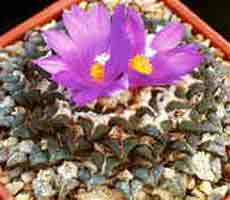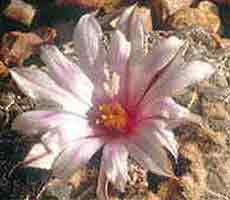|
Original
Publication
Anhalonium kotschoubeyanum
Lemaire, (1842) Bull. Cercle. Confer. Hort. Dep. Seine.
First published as a species of
Ariocarpus by Schumann in 1894.
Ariocarpus sulcatus Schumann K.
(1894) in Engler & Prantl, Nat. Pflanzenfam. 3,
6a:195
The name was corrected by Schumann in
1898.
Ariocarpus kotschoubeyanus
Schumann K. (1898) in Engler, Bot. Jahrb. 24:544.
|
|
|
Description |
|
 A. kotschoubeyanus
'elephantidens', the larger growing southern form of the
species.
A. kotschoubeyanus
'elephantidens', the larger growing southern form of the
species. |
|
Plant dark olive-green, seldom rising above
ground level, subglobose, flattened on top, depressed centrally,
1-3 cm high, 2-7 cm in diam.; tubercles laterally divergent,
elongate basally, becoming broadly triangular and flattened in the
distal portion, usually acute at the apices, flattened adaxially
and slightly fissured, 5-13mm 15mm long, 3-10mm wide, nearly as
broad as long; areoles central longitudinal grooves on the adaxial
surfaces of the tubercles, woolly, 1-3 mm wide, 5-10 mm long;
flowers 1.5-2.5cm in diam., 1.8-2.5cm long; outer perianth parts
magenta or white, 1.5-2.3cm long, 3-6mm broad; inner perianth parts
magenta or white 1.4-2.1 cm long, 4-6mm broad; pistil rarely
exserted above the stamens; style 1.4-1.6cm long; stigmas 4-6,
1-2mm long; fruit reddish to pinkish, 5-18mm long, 1-3mm in
diam.
|
Distribution (Map)
Very widely
distributed as a large number of discrete populations, generally on
limestone derived gypsum silt plains and hills, at elevations of
around 1000-1400 metres. The distribution extends over 600 km, from
central Coahuila in the north to Queretaro in the south, and the
species is also found in the states of Zacatecus, San Luis Potosi,
Nuevo Leon and Tamaulipas. The northern populations are
characterized by a form, which has become known as A.
kotschoubeyanus. var. macdowellii, this is found to the west
and east of Parras with a range of over 100km from Viesca to
Estatcion Marte in Coahuila. A. kotschoubeyanus. var.
macdowellii is a smaller plant than the type, with small
beak-like tubercles and pale mauve flowers, often with a high white
content in the outer petals. In contrast the most southerly form
found in the area around
|
Vista Hermosa in
Queretaro, and known as A. kotschoubeyanus var. elephantendens, is a much
larger plant with larger, highly textured, triangulate tubercles,
and a deep purple flower with little or no white content. In
Tamaulipas another small growing form of the species occurs with
almost white flowers, this has been described as A.
kotschoubeyanus var. albiflorus. The type species, which
is the earliest described and the most studied and documented form,
is intermediate between all the above forms and is to be found off
highway # 80, between El Huisache Junction and Santo Domingo. As
with most other widely distributed species of this Genus there
appears to be geographical clines, in this case a north - south
cline and a west - east cline.
|
|

A. kotschoubeyanus
'macdowellii, the smaller tubercled Northerly
form
|
|
|
Comments |
|
|
|

A. kotschoubeyanus
'albiflorus' flowering in September.
|
|
All forms and
varieties of this species are worthy of cultivation and help give a
feeling of the effect of habitat geographies. The plants are of
easy cultivation in a mineral gritty, clay loam, limestone
compost. A. kotschoubeyanus flowers reliably from
mid-August onwards, and is easy to set seed on, it produces some
interesting hybrids with other Ariocarpus
species.
Field Numbers
A
full listing of all associated field data can be found on the field number reference pages.
|
|